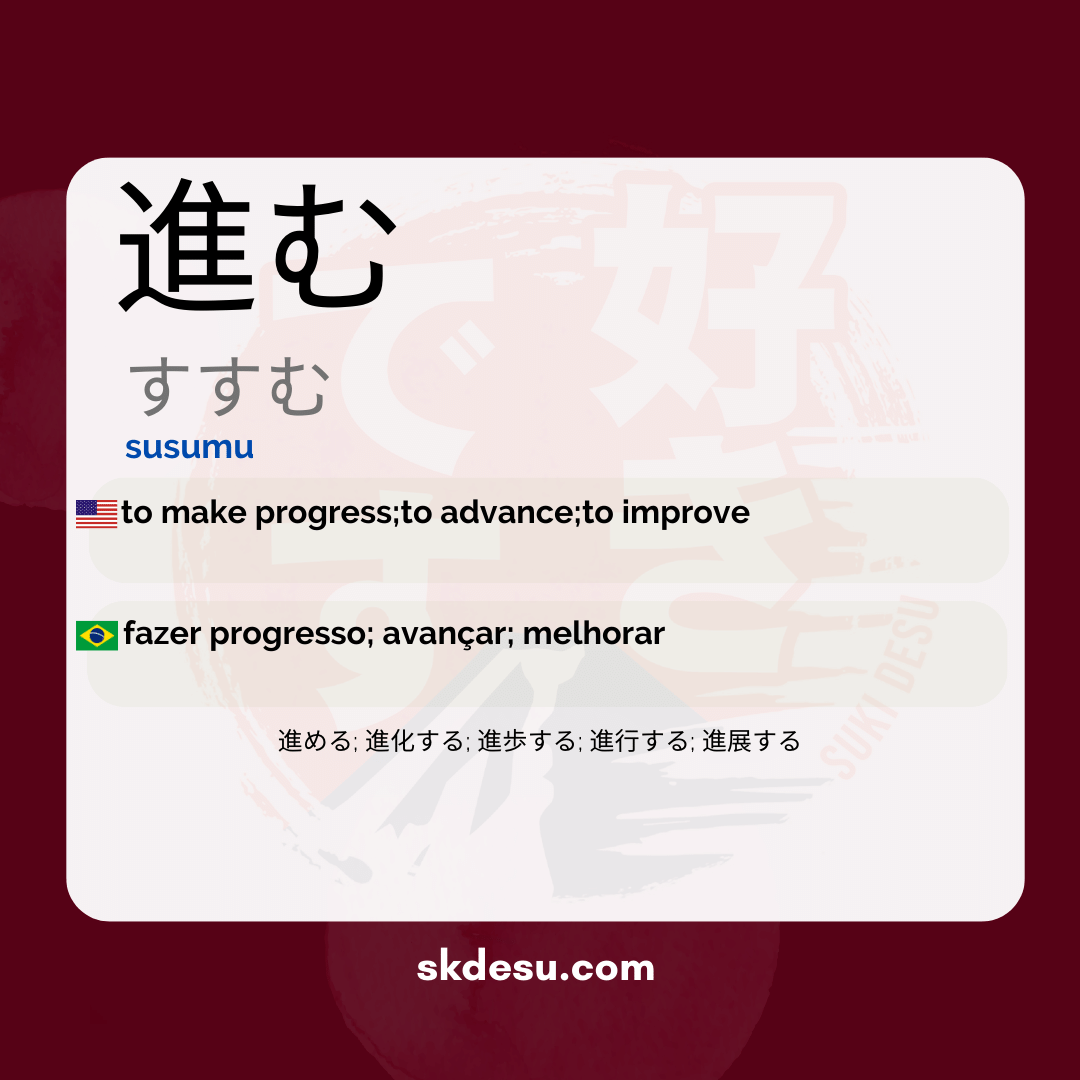Translation and Meaning of: 進む - susumu
The Japanese word 進む (すすむ, susumu) is an essential verb for those learning the language, as it frequently appears in everyday conversations, formal texts, and even in media such as animes and dramas. Its main meaning is "to advance" or "to progress," but like many words in Japanese, its usage goes beyond the literal translation. In this article, we will explore the meaning, origin, and contexts in which 進む is used, as well as tips for memorizing it effectively.
Meaning and use of 進む
進む (susumu) is a verb that carries the idea of moving forward, whether physically, like walking towards a place, or abstractly, like progressing in a project. For example, if someone says 「道を進む」 (michi o susumu), it means "to follow the path." In a professional context, 「仕事が進む」 (shigoto ga susumu) indicates that the work is advancing.
Furthermore, 進む can express technological or social development, as in 「技術が進む」 (gijutsu ga susumu), which refers to the advancement of technology. This versatility makes the word widely used in different situations, from informal conversations to academic discussions.
Origin and writing in kanji
The kanji 進 is composed of the radical 辶 (which indicates movement) and 隹 (a radical related to birds). This combination suggests the idea of "moving forward," reinforcing the meaning of the verb. The reading すすむ (susumu) is the most common, but the same kanji can also be read as "shin" in compounds like 進行 (shinkou, "progress").
It's worth noting that 進む is not just an action verb, but also reflects Japanese cultural values such as perseverance and continuous improvement. For this reason, it is often used in motivational contexts, such as in encouragement phrases or speeches about overcoming challenges.
Tips for memorizing and using 進む
An effective way to remember 進む is to associate it with everyday situations. For example, think of a person walking down a street or a project that is progressing. Creating mental images helps to recall not only the meaning but also the context in which the word is used.
Another tip is to practice with simple sentences, such as 「前に進んでください」 (mae ni susunde kudasai, "Please, move forward"). Repeating it out loud and writing the kanji a few times also reinforces learning. Over time, using 進む will become more natural, especially if you incorporate it into daily conversations or studies.
Vocabulary
Expand your vocabulary with related words:
Synonyms and similar words
- 進める (susumeru) - Advance, promote, encourage
- 進化する (shinka suru) - evolve, develop
- 進歩する (shinpo suru) - progress, improve, continuous advancement
- 進行する (shinkō suru) - to progress, to move forward (in a process)
- 進展する (shinten suru) - develop, progress towards a goal
Related words
Romaji: susumu
Kana: すすむ
Type: noun
L: jlpt-n4
Translation / Meaning: make progress; advance; to improve
Meaning in English: to make progress;to advance;to improve
Definition: Things advance and progress.
Quick Access
- Vocabulary
- Writing
- Sentences
How to Write in Japanese - (進む) susumu
See below a step-by-step guide on how to write the word by hand in Japanese. (進む) susumu:
Example Sentences - (進む) susumu
See below some example sentences:
Don don susunde ikou!
Let's move forward quickly!
Let's go constantly!
- どんどん - adverb that indicates something happening quickly or in large quantity
- 進んで - verb "to advance" in the gerund, indicating an action in progress
- いこう - verb "to go" in the future, indicating an action that will be performed
- ! - exclamation mark, indicating enthusiasm or emphasis
Maeoki ga nagasugiru to hanashi ga susumanai
If the intro is too long
If the intro is too long, the story will not proceed.
- 前置き (maezuki) - introduction, preamble
- が (ga) - subject particle
- 長すぎる (nagasugiru) - to be too long
- と (to) - Quote particle
- 話 (hanashi) - conversation, story
- が (ga) - subject particle
- 進まない (susumanai) - not progress, not advance
Seme no shisei de zenshin shiyou
We will move forward in an aggressive posture.
- 攻め - It means "attack" or "offensive" in Japanese.
- の - particle that indicates possession or relationship between two words.
- 姿勢 - It means "posture" or "attitude" in Japanese.
- で - particle that indicates the means or method used to perform an action.
- 前進 - It means "advance" or "progress" in Japanese.
- しよう - imperative form of the verb "suru", which means "to do". In this case, the phrase means "let's make an advance with an offensive attitude".
Maggoku ni susumimashou
We will move forward with determination.
Let's go straight.
- 真っ直ぐに - adverb that means "in a straight line"
- 進みましょう - verb in the imperative that means "let's move forward"
Susumi tsuzukeru koto ga taisetsu desu
It's important to keep moving forward.
It's important to keep going.
- 進み続ける - continuous progress
- こと - abstract noun
- が - subject particle
- 大切 - important, valuable
- です - Verb to be/estar in the present
Other Words of this Type: noun
See other words from our dictionary that are also: noun

